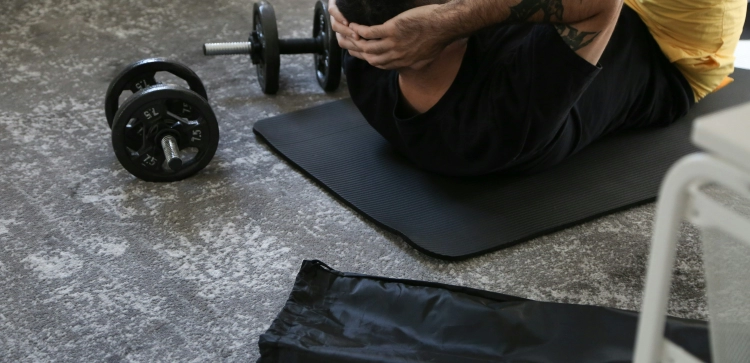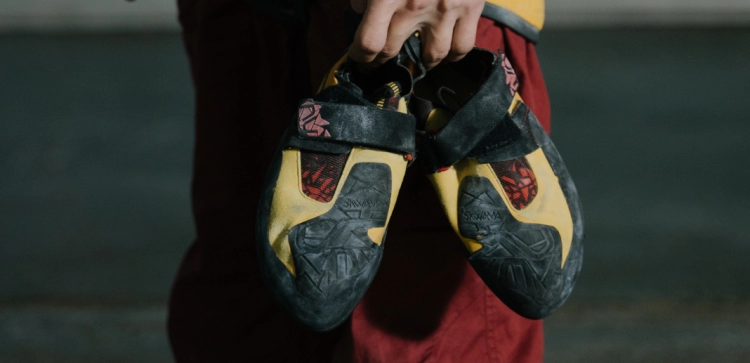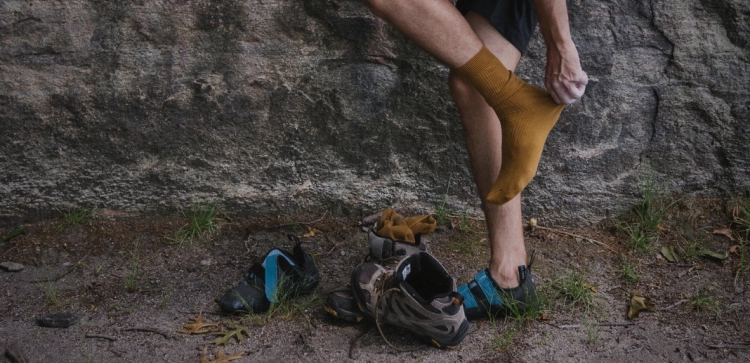







Climbers Point
While generally you can go climbing without climbing shoes, it is highly recommended to wear climbing shoes. Some indoor gyms also require the use of climbing shoes and forbid climbing in anything other than them.
You don't need to wear socks with rock climbing shoes, most people don't, but many people do for different reasons.
If you have blisters, wounds, or want to prevent blisters, a thin pair of socks can help quite a bit with that.
If your shoes are a little bit too loose, socks could help tighten them up.
Some people also just like climbing with socks.
Climbing shoes are generally designed to be very snug around your feet, with no socks in between them and your feet, but in the end it's up to you if to wear socks or not.
The amount of time it takes climbing shoes to break in and to stop being painful depends on a few things, such as the specific shoes, their size, the material of the shoes, and how often you climb in them.
The most important thing is to, first, get the right shoes for your feet, and the right size. If you get shoes that just don't fit your feet, it won't matter what size you get, they just won't be a good match for your feet.
The same goes with sizing. Even if you find the perfect shoes that match the shape of your feet perfectly, but you don't get the correct size, it won't matter that they fit like a glove.
Both things go together and both can determine how long the break-in period will last, and how long the shoes will hurt, if they even will.
Here is some more information on breaking in climbing shoes.
Even beginners can benefit from climbing shoes, this is especially true for outdoor rock climbing, where climbing shoes can be considered a necessity.
Some indoor climbing gyms also require all climbers to climb in climbing shoes, even beginners and first-timers, so climbing shoes would be a must in that situation.
To make a point about climbing shoes and getting used to them – it's better to start earlier than later. Climbing shoes are very different from your everyday shoes. They are tight and uncomfortable, at least in the beginning until you get used to them. That's why it's better to just get it out of the way and start wearing them. The sooner you get used to them, the better.
Most climbers prefer not to wear socks with climbing shoes, though, there is no rule against it.
Many climbers do in fact wear socks with climbing shoes for different reasons. Their shoes may be slightly too loose, and wearing socks could give them that extra layer that tightens things up.
Wearing socks could also help prevent blisters, or reduce pain if there are already blisters or other wounds on your feet as well.
So just because most climbers don't wear socks with climbing shoes, it doesn't mean there are no cases where it can be very helpful. Some people also just prefer sock in climbing shoes. It's up to you in the end.
There are a few scenarios in which climbing shoes may hurt:
1. If you are a new climber, and you are not used to climbing shoes
If you are a new climber, and you are not used to climbing shoes, they may hurt at first and be very uncomfortable. Climbing shoes in general are not very comfortable, and this sometimes causes pain to seem much worse than it is for beginners. After a few sessions, new climbers usually get used to the feel of climbing shoes. It's recommended to start out with flat or beginner level shoes, as the more aggressive climbing shoes can be difficult to get used to from the start and may be much more painful than flat beginner shoes.
2. If your climbing shoes are new and they haven't broken in
Climbing shoes that are new and haven't broken in is a very common reason for painful shoes. This is especially true if you downsize your climbing shoes. Once your shoes are broken in, the pain should be reduced or eliminated completely. If it is not, your shoes may just not be the right size or shape for your feet.
3. If your climbing shoes are just not right for your feet
Another common reason for feeling pain in climbing shoes is if you bought shoes that are not the right size or not the right shape for your feet. Feet come in all shapes and sizes, as do climbing shoes. Not all climbing shoes fit all shoes. Many new climbers decide to get what most others in their climbing gym say are the best shoes, or they get what they see most others wearing. Just because most wear them, doesn't mean they match your feet, and this is something many climbers don't realize.
It's important to get the shoes that match your feet and at the right size. If you have wider feet, get wider shoes. If you have narrow feet, get narrower shoes. There are shoes that are made specifically for wider and narrower feet, such as the Mad Rock Drone, they have a high volume version for wider feet climbers, and a narrower version for narrower feet climbers.
Find what works for you, not what works for others.
Climbers wear small sized shoes because climbing shoes are meant to be very minimal and snug. When climbers wear climbing shoes that are slightly smaller than their actual shoe size, these attributes are slightly enhanced, as is the performance a climber can gain from wearing smaller climbing shoes.
This can be a double-edged sword, though. If a climber wears climbing shoes that are too small, they may not gain any of the benefits climbing shoes provide, and may actually worsen their performance, not to mention injure or damage their feet.
Finding the right climbing shoes and the right size are not as simple as some may think. It takes going through a few shoes and trying new ones out until you find the right pair for you.
Your toes should be slightly curled inside the shoes, though, this depends on how aggressive the shoes are, the size of the shoes, and the shape of them.
If you have wide feet, you should try to find shoes that are wider and have a wider toe box. If you have narrower feet, you should find shoes that fit a narrow foot shape. This all makes a difference in how your foot will look and feel inside the shoes.






